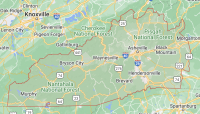Reaching out for the Little T
When Cass and Mary Lou Combs attended a conservation celebration along the shore of the Little Tennessee River in Macon County last Friday, their mind occasionally wandered from the speaker at hand to thoughts of a new great-grandchild being born that same day.
The timing actually was quite fitting. That great-grandchild was the reason they were there in the first place, being honored by the Land Trust for the Little Tennessee for placing their land in a conservation easement.
“We wanted to keep that piece of property in the status quo so our great grandchildren and their great-grandkids can walk over the bottom,” Cass Combs said of his 16 riverside acres along the Little Tennessee.
Over the past four years, the Land Trust for the Little Tennessee has reached out to like-minded landowners, cobbling together a corridor of protected lands along the Little Tennessee. More than a dozen cooperative conservation projects have been carried out by the Land Trust for the Little Tennessee and landowners to protect 5.5 miles of river frontage in recent years.
“What we are celebrating today is the most extraordinary river corridor in the Southern Appalachians if not the Southeast,” Paul Carlson, director of the Land Trust for the Little Tennessee, said at the annual spring celebration April 28. “It is the only river we know of that has all the species it was home to 250 years ago during the birth of our nation. No other river corridor can claim that.”
The Land Trust for the Little Tennessee has been instrumental in finding conservation-oriented landowners and matching them up with grants to pull off a mix of conservation easements in some cases and the outright purchase of land slated for development in other cases.
Related Items
For example, a family with farmland is a perfect fit for a Farm and Ranch Land Protection grant from the U.S. Department of Agriculture. Meanwhile, a property owner with endangered species is eligible for a habitat grant from the U.S. Fish and Wildlife. And when a section of land along the river is slated for development — threatening the river with sediment — a grant from the North Carolina Clean Water Management Trust Fund can help purchase the property.
Carolyn Wells with U.S. Fish and Wildlife said the Land Trust for the Little Tennessee provides the missing link in the conservation puzzle that other communities lack.
“Thanks for working with us to get those funds to the places where they need to be,” Wells told the land trust staff. “It is an exemplary watershed protection effort. This is a model throughout the Southeast. If only more watersheds were being protected as wholly as this is being.”
Bill Holman, director of the North Carolina Clean Water Management Trust Fund, called the Little Tennessee “one of the most comprehensive river protection” efforts in the south. “You aren’t just doing one little project in isolation. You have a plan and are working toward a long-range vision.”
Holman said the region has all the right ingredients.
“You have great landowners who care about protection of the land for the next generation and the next generation after that, and you have a great local land trust,” Holman said.
Carlson said the Little Tennessee was a major military and commerce artery for the Cherokee nation, a role that extended into Colonial times.
“People do not realize that in this valley was the biggest town west of Charleston,” Carlson said. “We are preserving an ancient landscape. There has been continuous agriculture in this river basin behind us for at least 2,000 years.”
The Land Trust for the Little Tennessee was instrumental in protecting the well-known Needmore tract — 4,500 acres spanning 21 miles of river. A massive campaign raised $19 million to buy it from Duke Power and stop it from being developed. The protection of Needmore is only part of the conservation story along the Little Tennessee.
“There’s been a quiet conservation movement unfolding,” Carlson said. “There’s been 5.5 miles of river corridor protected in 14 projects outside Needmore.”
Protection of the Needmore Tract — and the public rallying cry surrounding it — signaled a turning point in the region’s collective attitude toward conservation, according to Bill Gibson with Southwestern Regional Commission. Gibson said protection of the Needmore would have been improbable 30 years ago.
“We already had half the whole region in protection through the national park and two national forests. Some people thought we already had too much,” Gibson said.
Gibson said philosophies changed, partly due to the proliferation of development. The Land Trust for the Little Tennessee propelled the momentum generated over the Needmore Tract to long-range conservation vision for the entire Little Tennessee watershed.
“It’s not easy but it is crucial,” Gibson said. “It’s important if for nothing else just to continue to have a place to go fish or layout or meditate.”









